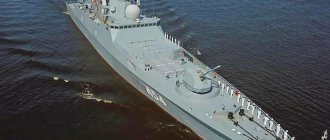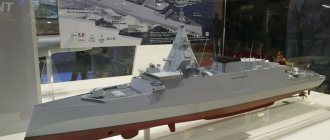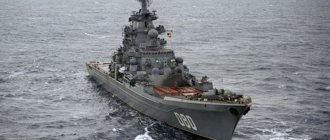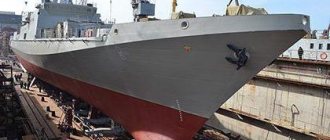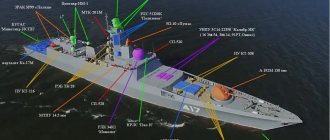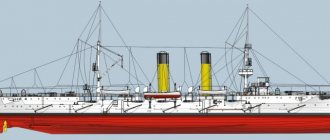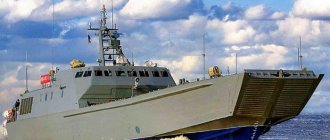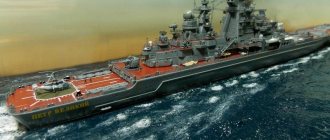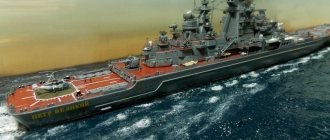Admiral of the Fleet of the Soviet Union Sergei Gorshkov during the Great Patriotic War commanded a brigade of cruisers, and subsequently served as Commander-in-Chief of the Navy for almost 30 years. It is not surprising that warships are named after him.
Previously, a heavy aircraft-carrying cruiser was named in honor of the admiral. Now the name of the naval commander has been assigned to a representative of the newest family - the multi-purpose frigate of Project 22350. These are not only completely new, modern ships, but also the first ones officially called frigates.
Origin of the name of the type and history of construction
The historical sailing frigate is a warship, fast and maneuverable, but not powerful enough to be used in the battle line. The name was first revived by the Royal Navy during the Second World War, giving it to light anti-submarine vessels.
In the American Navy after the war, air defense missile cruisers were called “frigates” for some time, but in 1975 the classification was changed. Thus, the modern frigate was finally defined as a small (in terms of displacement) air defense and anti-submarine defense ship.
In the Soviet Union, smaller vessels of this type were called “sentry”, and larger ones were called “large anti-submarine”. This classification was inherited by the Russian fleet. But in recent years, the term “frigate” has also begun to be used in Russia. And one of the first was “Admiral Gorshkov”.
For a long time, the basis of the Russian naval forces were ships designed and built during the Soviet era.
Moreover, the ships could be good in themselves - but the tasks facing the fleet have changed. What was needed was no longer “aircraft carrier killers” armed with heavy anti-ship missiles, but ships capable of effectively fighting piracy and supporting anti-terrorist operations.
Unfortunately, the difficult economic situation in the country did not always make it possible to even maintain existing combat units, let alone develop new ones. For example, the Yaroslav the Wise patrol ship was laid down back in 1988, but it entered service only 20 years later.
Only towards the end of the first decade of the 21st century did Russia again begin to build truly new and modern combat units for the Navy. The direct ancestors of the Admiral Gorshkov are patrol ships of Project 11540. These are ships developed and laid down in Soviet times. They refused to build the third ship in the series, even according to a modernized design, finding it did not fit into the fleet development plans.
The lead frigate of the basic project 22350 was laid down in 2006 in St. Petersburg. Four years later, the launch took place. In the future, according to the Commander-in-Chief of the Navy, such ships will become the main ones in the Russian ocean fleet. In the meantime, two frigates, Admiral Gorshkov and Admiral Kasatonov, are being tested. Two more ships of Project 22350, Admiral Golovko and Admiral Isakov, have not yet been launched.
THE LAST PARADE OF THE "ADMIRAL"
On the eve of 1998, preparations for the unique operation of towing it from Murmansk to Severodvinsk were largely completed on the Admiral Gorshkov.
The tugs had to drag the aircraft carrier 810 km from the Barents Sea to the White Sea through water and through ice, the thickness of which could reach half a meter. No aircraft carrier in the world has ever made such a transition through ice. Moreover, previous operations to tow the Northern Fleet cruisers Murmansk, Alexander Nevsky and the large anti-submarine ship Admiral Isakov ended in failure. "Nevsky" and "Isakov" sank, "Murmansk" was thrown onto the rocks by a storm. Note that these ships were many times smaller in size than the Gorshkov, and they were towed in more favorable conditions - in clear water, free of ice.
How can one not recall the towing of the helicopter carrier “Moskva” from Sevastopol to the Indian port of Alang. This operation was performed by the rescue tug "Stakhanovets". According to its captain Alexei Novikov, the Moskva managed somehow at sea, but it was difficult to tow it. In the Bosphorus, the cruiser turned across the strait five times. Then, due to the strong roll of the Moskva, they had to make a forced stop in Cape Town, where the Stakhanovets and the cruiser stayed for eight days. As a result of reballasting carried out in Cape Town, the ship became uncontrollable. Nevertheless, they managed to bring it to Alang, albeit with a two-month delay, which served as the basis for material claims against the tugboat crew and the arrest of the ship by the Indian authorities.
In all previous cases, the towed objects were converted ships without crews. There were supposed to be 450 sailors on the Gorshkov. At the same time, the TAVKR, due to its lack of propulsion, differed little from the converted helicopter carrier Moskva. It is no coincidence that in all documents “Gorshkov” appeared not as a warship, but as a towed object.
Towing was planned to begin in the second decade of January and be completed within four days. This operation was entrusted to three sea tugs, one road tug and two rescue vessels of the auxiliary fleet. In addition, it was planned to carry out navigation through the ice in the White Sea by an icebreaker. By the way, escorting a tug in the ice, according to Captain 1st Rank Andrei Azarov, who was the commander of the cruiser at that time, was not provided for in the tactical form. The strength of the hull allowed the aircraft carrier to independently break solid ice up to 30 cm thick, and if the ice was finely broken with a density of 5–6 points, up to 1.5 m thick. The aircraft carrier's hull could withstand this thickness while moving at a speed of 8 knots under its vehicles. No other calculations were made, and certainly no one carried out tests of the ship in ice. That is, only calculated specification data existed. In the tactical form of the aircraft carrier, there was a dash in the column “Accompanying the icebreaker.”
The winter Arctic prepared a severe test for the sailors along the crossing route. In January, the wind speed here drops below 12 meters per second for only 1–1.5 days. Therefore, the caravan of ships had to experience the force of the wind, the speed of which in gusts reached 20 meters per second, and the sea state was 3-4 points. During the entire passage to the White Sea, the sailors would not have seen the sun, which in these places appears over the horizon only in the second half of January. But they could not avoid thick fogs and snow storms, in which nothing was visible at arm's length. At the throat of the White Sea, the caravan would be trapped by ice, which, according to long-term forecasts, could reach half a meter in thickness. Under these conditions, the deviation of the aircraft carrier’s bow to the side from the channel laid by the icebreaker was tantamount to ice captivity, and the rescue of the steel bulk of the Gorshkov from it would have delayed the caravan on its way for at least a day. Of particular danger was the drift of the ice field, which could delay ships at sea for an indefinite period of time.
Forecasters from the Northern Fleet promised that the average air temperature would be 10 degrees below zero, and in the throat of the White Sea the thermometer could drop to minus 40 degrees. In such cold and icy winds, the boatswain's crew had to service the equipment and perform mooring and towing work on the upper deck. The rooms of the bow mooring device, poop and God knows how many others were not heated, because the operation of boilers on the cruiser was prohibited since 1994. It was planned to provide personnel quarters with heat from a “land” mobile boiler unit, which was delivered to the ship specifically for the period of transition.
Brief description of the design
The frigate's hull has a long forecastle, and a double bottom extends from the bow to the engine room. In order to reduce the likelihood of the ship being detected by enemy radars, its superstructure is made of carbon fiber-based composites. Such materials absorb radio waves well.
In other words, “Admiral Gorshkov” was built using “stealth” technologies.
The frigate's power plant is of a combined type. In it, a diesel engine and a gas turbine operate on each of the propeller shafts. The power of turbines is 27,500 hp, and diesel power is 5,200 hp. The total power of the entire installation reaches 65,000 hp. The vessel uses fixed pitch propellers. The frigate is equipped with pitch stabilizers. Seaworthiness, ultimately, should allow the Admiral Gorshkov to conduct combat operations even in a force five storm.
The frigate's main artillery caliber is a universal 130mm automatic cannon in the A-192 mount. The previous gun mount of a similar caliber - the AK-130 - had a mass of over 80 tons. This limited its use only to large ships - cruisers and destroyers. The weight of the A-192 installation is only 25 tons, and it can be installed even on small ships such as frigates.
The rate of fire reaches 30 rounds per minute, the cannon can hit ground and sea targets at ranges of up to 23 kilometers. When using the gun as an anti-aircraft gun, the reach is 18 kilometers in altitude.
Small-caliber artillery is represented by two Broadsword anti-aircraft installations, one per side. Each installation carries two six-barrel automatic guns GSh 6-30KD, the rate of fire of which is up to 10 thousand rounds per minute (in total). "Broadswords" hit air targets at altitudes of up to 3 kilometers.
The Admiral Gorshkov's missile weapons are located in the nose of the hull in universal vertical launch systems.
Two UVP ZS14U1 contain eight cells each, into which missiles for various purposes can be loaded. The Onyx medium-range anti-ship missile allows you to hit ships at ranges of up to 300 kilometers, the mass of the warhead is 300 kilograms. It is invisible to radar and is used on a fire-and-forget basis.
Another option is Kalibr cruise missiles. This missile is universal and, depending on the version, can be anti-ship, anti-submarine or tactical for hitting ground targets. The flight range is up to 300 kilometers (like the Onyx), the warhead can be penetrating or high-explosive fragmentation. Guidance – inertial and radar. Anti-submarine missiles carry a torpedo as a warhead.
Finally, in the future the frigate will be able to use Zircon missiles, which have not yet entered service. These anti-ship missiles are distinguished by extremely high (hypersonic) flight speeds. Re-equipping Russian ships with these missiles could, according to some estimates, reduce the role of aircraft carriers and force the development of new missile defense systems.
The air defense of the Admiral Gorshkov is provided, in addition to artillery, by the Redut missile system. Its launchers are also in the nose, in front of the ZS14U1. The ammunition capacity includes up to 32 long-range 9M96 missiles (launch range - up to 120 km) and up to 128 close-range missiles 9M100 (range - about 15 km).
The frigate is protected from enemy submarines by two quadruple “Packet-NK” installations.
They hit submarines with small-sized 324 mm torpedoes, and attacking torpedoes with M-15 rocket-propelled anti-torpedoes. The deck hangar of the Admiral Gorshkov accommodates the Ka-27 helicopter, traditional for the Russian fleet.
Why Russia was forced to make a choice in favor of Project 11356 URO frigates
You can laugh as long as you like at the Great Maritime Power Ukraine, waging bloody battles in the vast expanses of the World Ocean from the Baltic to the Black Sea and from the North Atlantic to the sultry Indian Ocean with the fragile ships of the Russian aggressor, but today’s story is about how it “sank” two the newest Russian frigates of the modified Project 11356 type "Burevestnik" "Admiral Butakov" and "Admiral Istomin", without even going to sea.
The next one she will drown will be the frigate of the same project, Admiral Kornilov.
Heavy frigates of project 22350
It all started back in 2014. More precisely, no, in 2014, with the annexation of Crimea to Russia, everything was already over, at least for our admiral-series frigates. They became perhaps the main victims of this undeclared war between Ukraine and the Russian Federation. And it all began bravura - with the laying of the lead ship of the admiral series (project 22350, the so-called heavy frigate, with a displacement of 4,500 tons) “Admiral of the Fleet of the Soviet Union Gorshkov” on February 1, 2006 at the St. Petersburg shipbuilding plant. It was the first large surface combatant laid down at Russian shipyards after the collapse of the USSR. In total, over the next 15-20 years it was planned to build up to 20 frigates, the base for which would be the ships of this project. It was assumed that they would be part of all four fleets of the Russian Navy. However, due to a number of reasons, the execution of the order slowed down significantly, and therefore, since 2011, the parallel construction of Project 11356 frigates for the Russian Navy, which were previously considered purely for export (the so-called light frigates, with a displacement of 3,620 tons), was launched.
Reference
: Project 22350 frigates of the “Admiral Gorshkov” type are a series of Russian universal multi-purpose frigates of the 1st rank with guided missile weapons (URL) for the distant sea and ocean zone. They were supposed to form the basis of the ship groupings of the Russian Navy in the Arctic zone, the North Atlantic and the Mediterranean Sea (note that about Syria, Sudan and the presence of the Russian flag in the Indian Ocean, then no one even thought about how quickly everything has changed since 2015!).
At the moment, two heavy frigates of this project are in service - “Admiral of the Fleet of the Soviet Union Gorshkov” (since 2018 as part of the Northern Fleet, built for 12.5 years since 2006) and “Admiral of the Fleet Kasatonov” (since 2020 as part of SF, was built a little less - 10.5 years from 2009). Another ship of this project was launched in 2022 and is preparing for mooring tests - “Admiral Golovko” (laid down in 2012, assigned to the Northern Fleet, at the end of 2022, if all goes well, delivery to the customer is expected). The fourth ship of this series, Admiral of the Fleet of the Soviet Union Isakov (laid down in 2013), is being prepared for launching this year (transfer to the customer is scheduled for the end of 2023). Another four “admirals” assigned to the Pacific Fleet are being built there in St. Petersburg at PJSC Shipbuilding - these are “Admiral Amelko”, “Admiral Chichagov”, “Admiral Yumashev” and “Admiral Spiridonov” (the first two were laid down in 2019, the second a year later - in 2020, delivery to the customer is planned for 2025-2026, respectively). Unlike the four previous “admirals,” they will receive more powerful weapons in the form of 32 vertical launchers of the UKSK complex (3S14 universal shipborne rifle complex), which is twice as many as on the first four ships. And finally, on August 25, 2022, at the Army-2020 forum, the Ministry of Defense of the Russian Federation signed a contract for the laying down of two more frigates of Project 22350 in 2021 (the same Severnaya Verf will be built, the serial numbers are already known, the name is not yet known) . There will be 10 heavy “admirals” in total. Ten for now. In the future, the Russian Navy plans to build ships of the far sea zone of this class according to the modernized project 22350M with an increased displacement of up to 8,000 tons (work on the project is underway).
Light frigates of project 11356
The hitch with the launch of the heavy frigates of Project 22350 into the series (the development and testing of the lead ship of this series, Admiral Gorshkov, was very difficult) gave rise to the reincarnation of the export project 11356 for the needs of the Russian fleet (received the letter “R” for this purpose).
Project 11356R itself is a modernized project of the export frigate 11356 type "Talvar", created for the Indian Navy, which in turn is a further development of the project of patrol ships 1135 and 1135M "Burevestnik", as well as border patrol ships 11351 "Nereus". During the period from 1968 to 1992, the USSR Navy and the Marine units of the USSR KGB Border Troops received a total of 39 ships of various modifications of this project. Their excellent seaworthiness and good living conditions won the legitimate sympathy of sailors. It is for this reason that the Indian side, when choosing a ship that was supposed to form the basis of its Navy, in 1997 opted for a time-tested, modernized patrol ship, although it was also offered more modern options at that time, but requiring improvement (Project 12441 Novik and project 11540 "Hawk"). It just so happened that initially ordered in only three units for a foreign customer, Project 11356 ships eventually became one of the most numerous series of warships in the post-Soviet history of shipbuilding in the Russian Federation. At the moment, the series includes 12 units, 9 of which have already been built and are serving in the Indian and Russian fleets. Not distinguished by any innovative solutions or the latest weapons, these ships are remarkable for their reliable and proven design with a relatively small size and cost.
Currently, six frigates of this series are serving in the Indian Navy - F40 "Talvar" ("Sword"), F43 "Trishup" ("Trident"), F44 "Tabar" ("Axe"), F45 "Teg" ("Sabre" ), F50 "Tarkash" ("Quiver") and F51 "Trikand" ("Bow"). The Russian Navy also has ships of this project - “Admiral Grigorovich” (as part of the Black Sea Fleet since March 2016), “Admiral Essen” (as part of the Black Sea Fleet since June 2016) and “Admiral Makarov” (as part of the Black Sea Fleet since December 2022 years), all three frigates have already registered in Syria. Three more “admirals” - “Admiral Butakov”, “Admiral Istomin” and “Admiral Kornilov”, in varying degrees of readiness, froze on the slipways of the Kaliningrad shipyard “Yantar”. There is only one reason - the lack of power plants produced by the Ukrainian side, which it refused to supply due to the events of 2014. More on this in the next article, but now I’ll finish with the Indian contract.
The ships of this project became the first representatives of the Indian fleet, built using stealth technologies and equipped with a vertical missile launch system. And if the first troika was equipped with the Club-N anti-ship missile system, consisting of a 3S-14 launcher designed for an ammunition load of 8 missiles, then on the second troika the Club missiles were replaced by 8 supersonic cruise missiles "BrahMos" of Russian-Indian design, which placed in the same vertical launch installation. The Indian side was very pleased with the ships they received. They have shown excellent results since their introduction in 2002. Senior Indian Navy officials believe that these are the most advanced ships available in the Indian Navy, with the right combination of air defense, anti-submarine and anti-ship defense capabilities.
Project 11356 URO frigates are a quiet horror for our enemies. Cheap and very cheerful!
Reference: Project 11356R frigates “Burevestnik” (according to NATO codification Krivak V) are a series of Russian multi-purpose frigates of the 2nd rank with guided missile weapons (URL) for the distant sea and ocean zone. Initially, their prototype patrol ships of Project 1135 and 1135M "Burevestnik", as well as their modifications 11352 and 11353 (according to NATO codification Krivak I, II, III and IV) were designed as LODs (large anti-submarine ships) for active ASW (anti-submarine defense). But at the request of the Indian side, they were transformed into multi-purpose guided missile frigates. In the same capacity, they replenished the composition of the Navy of the RF Armed Forces.
But, what is especially important and what I draw your special attention to is that in both the Indian version 11356 and the 11356R version for the domestic Navy, the developers followed the path of simplifying and reducing the cost of the weapons used.
And if the Indians initially focused on creating a budget version of the URO frigate (and now they are not abandoning this), then we were forced to do this when the project of the heavy frigate 22350, equipped with the Poliment-Redut collective defense air defense system, which had not yet been adopted into service, stalled (namely Because of problems with it and bringing it to fruition, the light frigate project 11356R was launched). The main reason for our haste became clear in 2015, when, to Obama’s horror, fair retribution rained down on the heads of his henchmen, soldiers of the terrorist organization ISIS (banned in the Russian Federation), who have been terrorizing the Bashar al-Assad regime in Syria since 2011, in the form of 26 of our rusty winged "Caliber" missiles, which, according to experts from Langley, should not have flown a distance of more than 300, well, a maximum of 450 km, but they, starting from the Caspian Sea from some inflatable mattresses that could not be seen even in a periscope, flew 1, 5 thousand km and fell on the heads of unsuspecting warriors of Islam, sending them to a meeting with the Almighty along a shortened route and ruining all the fun for their curator from Washington. This came as a complete surprise to the heavily tanned leader of the American pale-faced Comanches, because all this time his advisers had assured him that the Russians did not have weapons with such a range that could threaten America. There are neither weapons nor their carriers equipped for the “sea launch” of cruise missiles (cruise missiles), and all that remains of the entire fleet are rusty submarines. You know the result, the warriors of Islam communicate with Allah, the poor students from Langley went to school to study where the Caspian Sea is located, and Obama, cursing the day when he sat down behind the wheel of his vacuum cleaner, retired and began writing memoirs under the general title “ Me and the Genius of Villainy Putin.” The Genius of Villainy needed large numbers of sea-based Caliber carriers (with an extended range) and he got them.
Long before these events, the General Staff of the Russian Navy revised the concept of forming its Navy, deliberately moving away from the creation of expensive BNK (large surface ships) of the 1st and 2nd rank in favor of cheap MRK URO 3rd rank (small missile boats with guided missile weapons ) projects 22800 "Karakurt" and 21631 "Buyan-M". It was these boats, located and moving through the inland seas and reservoirs of the Russian Federation (including rivers!), being inaccessible to the enemy’s missile defense system, that, according to the plan of the staff of the General Staff of the Russian Navy, were supposed to deliver that very blow of terrible force that our enemies are so afraid of. The light frigate URO of Project 11356R was designed to serve the same tasks, having excellent time-tested seaworthiness and the ability to operate in the ocean and far sea zone (unlike small missile ships, which are not intended for this, the destiny of which is coastal navigation in the near sea zone), it and was supposed to bring our weapons of retaliation to those areas of the globe where our little RTOs were denied access. And taking into account the cost of the project, we can summarize that the Russians again defeated the West not with numbers (money), but with skill (and ingenuity).
Disadvantages of the 11356R project
And don’t be confused by the fact that this project is built mainly on technologies and weapons systems of the 1990s, which, according to the plans of the customers in the Russian Navy, was supposed to speed up the construction and commissioning of ships.
Moreover, I will say that even in comparison with the Indian project 11356 “Talvar”, some of the systems were removed, for example, 11356R lost its towed sonar. The other part was replaced with simplified analogues, in particular, an outdated under-keel sonar was installed (the maximum detection range of the MGK-335 is 12 km, versus 15 km for the not-so-modern APSOH in the Indian version and 18-45 km for the Zarya sonar on projects 20380/22350) , not the most modern Kashtan air defense systems have been replaced by even older AK-630M. PLO (torpedo tubes) and anti-torpedo defense systems RBU-6000 (RGB-60, 90R, 90R1) have excess weight and reduced performance characteristics, for example, compared to the Package-NK complex. And the 3S90M + 9M317M air defense system is less advanced in terms of performance characteristics and weight compared to the Redut air defense system on Project 22350 frigates. Not to mention that the Requirement-M BIUS installed on the 11356R frigates is also inferior in automation capabilities to the Sigma BIUS. frigates 22350 and corvettes of project 20380. This is all nonsense compared to the most important thing - the frigates of project 11356R were regularly equipped with the Caliber-NK missile system. And although the vertical launcher 3S14, installed on ships of projects 11356R and 21631 (MRK Buyan-M), has truncated capabilities and allows the deployment of only missiles of the Caliber 3M14 family, i.e. does not allow the deployment of anti-ship missiles "Onyx", in contrast to similar UKSK on ships of projects 20385 (multi-purpose URO corvettes of the 2nd rank), 22350 (heavy frigates URO of the 1st rank) and 1144.2M (TARK, heavy nuclear missile 1st rank cruiser of the Orlan project), but she solves her task of cheaply and cheerfully delivering weapons of mass destruction to enemy control centers. This project served these purposes and that is why the blow our brothers dealt to it was so painful and tangible for us.
By the way, their only ship - the flagship and pride of the Navy, the frigate "Getman Sahaidachny" also belongs to this project, or rather to its prototype - the SKR (patrol ship) of project 11351 "Nerey", laid down in Kerch in 1990 by order of the Naval Forces of the Border Troops of the KGB of the USSR and inherited from Square after the collapse of the Union. True, it can be called a frigate with great stretch, because it does not carry missile weapons. But, nevertheless, this did not stop him from sinking two of our newest frigates of Project 11356R and causing holes in four more “admirals” that never received Ukrainian engines. But more on that next time.
Combat characteristics of Project 22350 frigates
It is noteworthy that there have also been changes in the composition of the US Navy. The main striking force is still heavy aircraft carriers, but the old frigates "Oliver Perry" have been replaced by "littoral" patrol ships of the "Freedom" and "Independence" projects. As another competitor of the "Gorshkov" we will consider the not new, but widespread German frigate of the MEKO family.
| Project 22350 | Littoral Combat Ship | MEKO 200 | |
| Displacement, tons | 5400 | 3100 | 3400 |
| Length, meters | 135 | 127 | 118 |
| Width, meters | 16 | 32 | 14,8 |
| Travel speed, knots | 30 | 44 | 32 |
| Artillery weapons | 1 x 130mm | 1 x 57mm, 2 x 30mm | 1 x 127mm |
| Missile weapons | 16 missile launchers "Onyx" and "Caliber" | 24 Hellfire missiles | 8 Harpoon missiles |
| Anti-aircraft weapons | 2 x ZAK "Broadsword", 4 x SAM "Redut" | 1 x ZRKSeaRAM | SAM SeaSparrow, ZAK Phalanx |
| Anti-submarine weapons | PLR 91Р2, 2 torpedo tubes | — | 2 Mk32 torpedo tubes |
| Aviation weapons | Ka-27 helicopter | Helicopter MH-60, UAV MQ-8 | Helicopter S-70 |
| Crew, man | 210 | 75 | 220 |
Comparing the tactical and technical characteristics, we can come to the conclusion: “Gorshkov,” if not a “superfrigate,” is not at all inferior in combat capabilities to its analogues. And it is quite capable of becoming a worthy competitor to German frigates if the ships of the project are exported.
But the characteristics of the newest American patrol boat make us think about the relevance of the comparison. The “littoral warship” departed too much from the established frigate concept. The caliber of the artillery gun is half as large, the anti-aircraft weapons are weaker, and the anti-submarine weapons are limited to the airborne helicopter. And the Hellfire light missiles are not at all a competitor to the Onyx anti-ship missiles.
If in their place there were at least Harpoon missiles, this would bring the possibilities closer together. Perhaps additional combat modules can significantly change the combat qualities of the LCS. The high speed and small crew size of the “Americans” deserve attention.
Tactical and Technical Characteristics
3.1 Main characteristics
- Displacement: 45,390 tons maximum, 44,490 tons full, 38,970 tons normal, 33,440 tons standard.
- Length: 242.86 m at the waterline, 273.08 m deep.
- Beam: 31.0 m at the waterline, 52.9 m deep.
- Height: 60.30 m overall. Side height (from the vertical line): 24.96 m at the bow, 21.63 m amidships, 21.61 m at the stern.
- Draft: average (from OP): with normal displacement 8.47 m, with full displacement 9.42 m. Maximum: 11.52 m.
- Armor: rolled steel, hull duplication with “dry compartments”
- Engines: boiler-turbine, four-shaft, 4 GTZA TV-12-3, 8 KVN 98/64 boilers.
- Power: steam turbines: 4 × 45,000 hp, turbogenerators: 6 × 1500 kW, diesel generators: 4 × 1500 kW.
- Propulsion: 4, four-blade.
- Travel speed: 14.05 knots of economic speed, 18.32 knots of combat economic speed, 29 knots of full speed, 32.5 knots of maximum speed.
- Cruising range: at a speed of 18 knots - 7590 miles.
- Navigation autonomy: 30 days.
- Crew: staff: 1615 people, with headquarters: 1665 people, air group: 430 people.
3.2 Armament
- Radar weapons: general detection radar: 1 × radar with phased array "Mars-Passat", 1 × radar MR-710M-1 "Fregat-M1", 2 × radar MR-360 "Podkat", 3 × radar "Vaigach". Aviation control system: 1 × “Resistor-K4”, 2 × “Lawn”.
- Electronic weapons: BIUS "Lesorub-434", communications complex "Buran", SJSC "Polynom", electronic warfare and electronic warfare complex "Kantata-M", electronic warfare equipment "Pogonya" and "Kaskad-U".
- Artillery: 2 × 1 AK-100 (600 rounds).
- Anti-aircraft artillery: 8 × 6 AK-630 (48,000 rounds).
- Missile armament: 6 × 2 Basalt anti-ship missile launchers, 4 × 6 Kinzhal air defense missile systems (192 missiles).
- Anti-submarine weapons: 2 × 10 RBU-12000 (60 bombs)
- Aviation group: 36 airplanes and helicopters. According to the project: 14 × Yak-41M VTOL aircraft, 6 × Yak-38M VTOL aircraft, 10 × Ka-27PL, 2 × Ka-27PS, 4 × Ka-27RLD.
Prospects, combat and service
The main thing you can expect from Admiral Gorshkov is trouble-free operation. Still, this is the first in a series that has no continuity with its predecessors. So, first of all, one must hope that he will not develop any serious “childhood diseases.” And that the main diesel engine, which managed to break down, will remain the biggest problem.
The frigate will most likely carry out patrol duty. Perhaps it will support the actions of ground troops with missile strikes (if they are not withdrawn from hot spots in the coming years).
And if Project 22350 ships are built in a large series, then they have every chance of becoming the main “workhorse” of the fleet (as the American destroyer Arleigh Burke is today). And frigates armed with Zircon missiles will have the opportunity to attack any, even the largest, enemy ships. And heavy cruisers will no longer be needed to destroy aircraft carriers.
Project 22350 frigates have opened a new, long-awaited page in the history of the Russian fleet.
Even the best Soviet-built ships have long been in need of replacement - and now it has come. The Navy began to accept new ships, created taking into account modern requirements.
The activities of Admiral Sergei Gorshkov as Commander-in-Chief are currently assessed differently. There is an opinion that instead of building nuclear cruisers, the Soviet Union should have paid more attention to aircraft carriers. But there is a certain symbolism in the fact that the name of the admiral was assigned to a small ship, but powerfully armed and quite capable (in the future) of coping with the role of a counterweight to aircraft carriers.
Options [edit]
- Project 22350
- Modernized project 22350 - with 24 VLS cells instead of 16.
- Etc. 22356 is an export version of project 22350, first presented at the international exhibition Euronaval-2010. [63] [64]
- Project 22350M - first introduced in 2014, the ship was named "Super Gorshkov" for its enlarged hull with an increased displacement of 8000 tons, pyramidal mast and 48 VLS cells for the Kalibr, Oniks and Zircon anti-ship cruise missiles being developed for the Russian fleet [37] Design work should be completed in 2022, after which it is planned to lay down the lead vessel of the modernized class. [65] [2]

